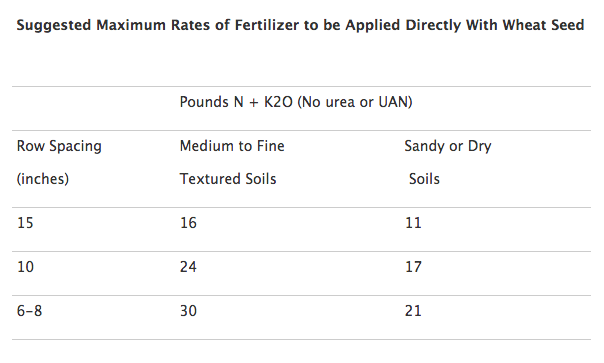Source: Kansas State University Extension
By Dave Mengel, Soil Fertility Specialist and Dorivar Ruiz Diaz, Nutrient Management Specialist
To save time and cost, some wheat producers may be thinking about adding a little extra nitrogen (N) as urea or UAN to their phosphorus fertilizer through the drill with the seed. This would either be in addition to, or instead of, any preplant N applications.
While a minimum preplant N application of 20 to 40 lbs N per acre is often desirable, especially in no-till production systems, it is important to avoid placing urea containing fertilizers in direct seed contact.
We suggest that NO urea or UAN solution be placed in contact with the seed. However, if the fertilizer N applied at seeding will be separated from the seed by 1 inch or more, urea-containing fertilizers can be used.

Here are some suggested maximum rates of fertilizer to be applied directly with wheat seed from Kansas State University Extension.
Application Methods
If the starter fertilizer can’t be “spiked” with urea to add extra N, how can the necessary 20 to 40 pounds of N be applied? One option is to use a polymer coated urea product such as ESN.
The coating slows the release of the urea from the pellet and lowers the concentration of ammonia near the germinating seed and initial roots. This approach has been used successfully in Canada with both wheat and canola.
Subsurface banding (knifing) of N as either anhydrous ammonia, liquid UAN, or dry product will result in the greatest N use efficiency by the wheat crop. This is especially true for no-till wheat production.
If knifed N applications are not used, the next best application method would be surface banding (dribbling) of UAN solution in streams on 15- to 18-inch centers.
Broadcast applications are not generally as efficient as subsurface banding, but they are often the best choice due to equipment, logistics, or weed management considerations. Broadcast applications of N will have a more consistent performance if followed by light incorporation, precipitation, or irrigation.






Post a comment
Report Abusive Comment